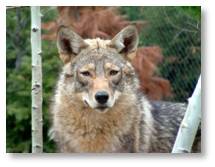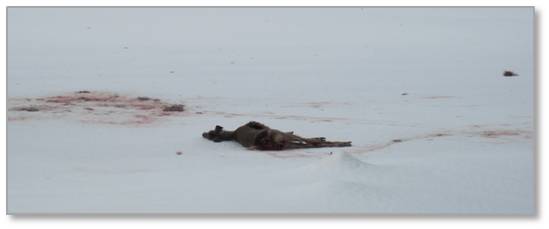Sometimes I stand on my front porch and listen to the pop-pop-pop of people shooting at the Hudson Rod, Gun and Archery Club to the west. Later that night I can hear the howls and cries of coyotes on the golf course to the east. Now if only I could put them together . . .
Don’t get me wrong, I don’t hate coyotes. Well, that’s not exactly true but I don’t like them at all. I know they perform a valuable service by keeping the rodent, rabbit, and other small animal populations down. They help keep our roads clean by vacuuming up road kill. The trouble is, they also kill small pets (and some bigger ones) as well.
In our house in Sudbury, we went through a few months when coyotes were coming down off Nobscot Mountain and cruising through the neighborhood. They did this because a misguided neighbor was feeding the birds with suet-based food. The coyotes loved the suet and seeds but they didn’t stop there. They also took out two of our cats and several more neighborhood pets as well. The woman who was feeding the birds stopped when she came home one day and found a coyote dismembering her own cat in the backyard.
I feel terrible when I see Lost Dog and Lost Cat signs posted on the telephone poles because I know the owners will never see those pets again. I first saw a coyote in 1993, emerging from the woods around a reservoir in Southborough. After that, I began seeing them by the sides of highways and even in the center of Acton, watching the rush-hour traffic.
Here’s the thing. The Eastern Coyote that we see here is a very different animal from either Wiley Coyote of Roadrunner fame or the Western Coyote (canis latrans) that we know from western movies, or the ones that howl in the canyons of Los Angeles. On their migration east, by way of Canada, they hooked up with Eastern Wolves (canis lycaon) to produce a new breed of canine predator.
According to the article “Canis Soup” by Elizabeth Royte in Outside Magazine, “it’s only within the past three years that scientists have been able to use better monitoring technology to prove “definitively that wolves and coyotes have interbred.” Ms. Royte says that this new hybrid animal demonstrates both size and hunting behaviors that are different from canis latrans. Here’s how the Eastern Coyote is different:
- It has bigger jaws.
- It is bigger and heavier
- It less shy of mankind
- It hunts in packs
- It commonly takes down large prey—as big as white-tailed deer.
I know the last one is true because it happened . . . in our backyard . . . in suburban Sudbury . . . right near the Boston Post Road. It was winter and the pond behind the house was frozen over and covered with four feet of snow. I was getting ready for work on Valentine’s Day when I looked out the window and saw a splotch of bright red on the snow over the pond. What? It had been pure white out there for many weeks. I looked closer and saw the doe’s body stretched out next to the blood spill. She had been fed on extensively.
Ms. Royte says this “exceptional behavioral plasticity” has allowed the hybrid to expand into territories where the top predators have been wiped out. In essence, they have taken over the biological niche once occupied by wolves and mountain lions.
The article quotes Robert M. Timm, a wildlife specialist at the University of California at Hopland, on how good coyotes go bad—by learning what they can get away with and pushing for more. First they appear in yards and streets at night. Next they start killing unleashed pets and “facing off against leashed dogs.” This is followed by chasing joggers and bicyclists. After this, they appear in children’s play areas at mid-day. Finally, they attack adults as they did with Taylor Mitchell in 2009. Running in Nova Scotia’s Cape Breton Highlands National Park, she was attacked and killed by coyotes that had been photographed by hikers ahead of her on the Skyline Trail.
We created this problem by killing off the apex predators, by putting pet food outside, by letting pets roam freely, by landscaping yards in ways that attract rodents, and by feeding the birds. What to do? If attacked, don’t act like prey. Be aggressive. Yell and throw things. Teach them to avoid humans and that’s what they will do.
BTW: Mystique goes out during the day (there is no keeping her inside) but she comes home at night and appears happy to stay inside. After all, she has probably heard them howling on the golf course, too, and has no desire to meet the Eastern Coyote face to face.



